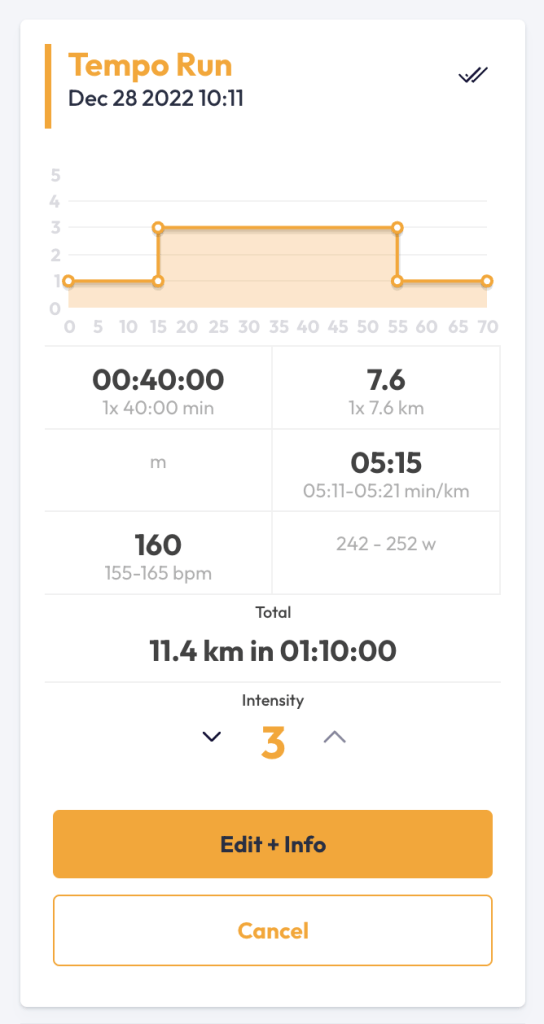Tabla de contenido
Some time ago, I read an article by Ed Eyestone about his experience when he started running after the winter season and some recommendations to come back.
Even many of us who are far from those climates and can go out in shorts and T-shirts all year long can also take some of these messages and apply them after long training breaks or times when there are still the remnants of the vacations. We are resuming the routine through aerobic work but without doing speed work.
Going back, to Eyestone’s article, when returning from winter, the runner has a good cardiovascular condition because he has kept training on the treadmill. He can run slow but he doesn’t have an excellent time when the speed is increased.
Ed Eyestone recommends the following routines to get in that speed work:
5-4-3-2-2-1 routine.
This hybrid routine quickens the pace as the interval distance gets shorter. Something similar to what we find in some of the speed work in the First plan. We warm up about two to three miles and start running a little faster than a tempo pace (say about 18 seconds faster than the 5k pace). We recover the same amount of time that the interval lasted (in this case from the first interval, five minutes easy). As we do a shorter interval, say four minutes, the pace gets faster.
Progressive tempo running routine
After warming up for about 10 to 15 minutes, run the first five minutes slightly faster than your light or gentle pace. Increase your speed every five minutes. The last five-minute segment for a total of 25 minutes (not counting the warm-up) should be run at your tempo pace.
400-meter routine with long-recovery
After warming up, run six to eight 400-meter sets, each of which you will run about 6 seconds faster than your 5-kilometer pace. Recovery will be a very gentle jog of three to four minutes between each set.
How estimate running paces for tempo training?
According to Daniels, this pace is, for many people, about 15 to 20 seconds per kilometer slower than the equivalent pace of a 5-kilometer run. For example, if we run 5 kilometers in 20 minutes, we would be running each kilometer in 5 minutes. In this case, the tempo would be about 15-20 seconds above this pace, i.e. at about 5:15-5:20.
If you want to do some simple calculations to estimate your training steps (including Tempo) from a recent 5K or 10K race result, I recommend checking out our step calculator.
In our personalized running.COACH training plans we will automatically calculate your Tempo routine.

What are the benefits of tempo training?
When the body metabolizes glucose, lactic acid is produced as a by-product. A tempo run increases the lactate threshold, which, to explain further, is essentially the point at which lactic acid begins to accumulate significantly in the muscles. In simple terms, this will help you run faster for longer, which is why Moses believes that “tempo running should be a basic part of the running ‘diet’ year-round.”
How often should we do tempo training?
As for the frequency of tempo training, some data we have found is that experts recommend no more than one session per week and that this should not exceed 10 to 15% of the total training for that week. Moses agrees, noting that “a tempo run doesn’t have to be done every week. You can readjust your microcycle training accordingly.”
Looking for a plan that trains with you, not against you?
At running.COACH, we don’t just build a schedule. We create a smart, living plan that evolves with you. It understands your level, your race goals and your real life. Whether you sync your GPS watch or train straight from our iOS or Android app, your plan adjusts automatically as you improve.
From day one, you’ll feel the difference:
- A fully personalized, dynamic plan designed for you.
- Automatic sync and effortless workout tracking.
- Real-time updates when life happens, including missed sessions, new races or schedule changes.
- Simple, science-backed guidance to train smarter and recover faster.
🎁 Start today and enjoy your first 30 days free.
Because the best training plan isn’t one you follow. It’s one that follows you.app.











0 Comments